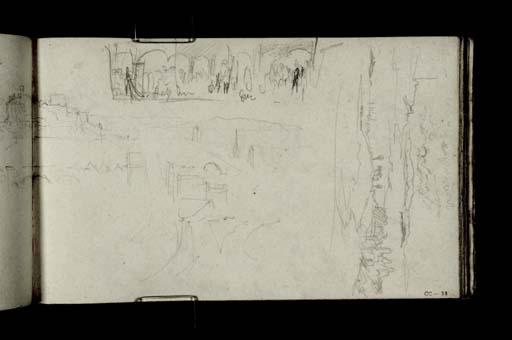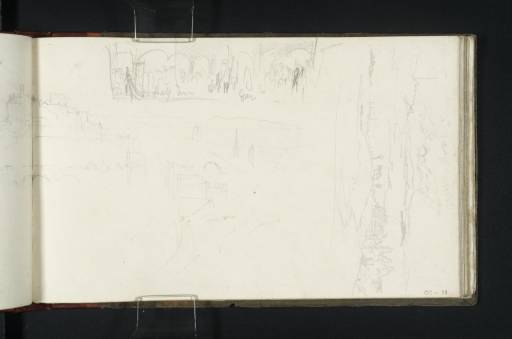Joseph Mallord William Turner Continuation of a View of Edinburgh from Calton Hill; Composition Perhaps Relating to the Regalia Ceremony at Holyrood; Granton Castle and the Firth of Forth with Inchkeith 1822
Image 1 of 2
-
 Joseph Mallord William Turner, Continuation of a View of Edinburgh from Calton Hill; Composition Perhaps Relating to the Regalia Ceremony at Holyrood; Granton Castle and the Firth of Forth with Inchkeith 1822
Joseph Mallord William Turner, Continuation of a View of Edinburgh from Calton Hill; Composition Perhaps Relating to the Regalia Ceremony at Holyrood; Granton Castle and the Firth of Forth with Inchkeith 1822 -
 Joseph Mallord William Turner, Continuation of a View of Edinburgh from Calton Hill; Composition Perhaps Relating to the Regalia Ceremony at Holyrood; Granton Castle and the Firth of Forth with Inchkeith 1822 (Enhanced image)Enhanced image
Joseph Mallord William Turner, Continuation of a View of Edinburgh from Calton Hill; Composition Perhaps Relating to the Regalia Ceremony at Holyrood; Granton Castle and the Firth of Forth with Inchkeith 1822 (Enhanced image)Enhanced image
Joseph Mallord William Turner,
Continuation of a View of Edinburgh from Calton Hill; Composition Perhaps Relating to the Regalia Ceremony at Holyrood; Granton Castle and the Firth of Forth with Inchkeith
1822
Joseph Mallord William Turner 1775–1851
Folio 36 Recto:
Continuation of a View of Edinburgh from Calton Hill; Composition Perhaps Relating to the Regalia Ceremony at Holyrood; Granton Castle and the Firth of Forth with Inchkeith 1822
D17564
Turner Bequest CC 36
Turner Bequest CC 36
Pencil on white wove paper, 114 x 187 mm
Inscribed in pencil by Turner ?‘Half In’ ?‘Gun’ centre top
Very faint sign of John Ruskin’s red ink inscription, ?‘36’ bottom right
Stamped in black ‘CC 36’ bottom right
Inscribed in pencil by Turner ?‘Half In’ ?‘Gun’ centre top
Very faint sign of John Ruskin’s red ink inscription, ?‘36’ bottom right
Stamped in black ‘CC 36’ bottom right
Accepted by the nation as part of the Turner Bequest 1856
References
1909
A.J. Finberg, A Complete Inventory of the Drawings of the Turner Bequest, London 1909, vol.I, p.611, CC 36, as ‘Edinburgh from Calton Hill, and other sketches.’.
1975
Gerald Finley, ‘J.M.W. Turner’s Proposal for a “Royal Progress”’, The Burlington Magazine, vol.117, January 1975, pp.32 note 27, 35 note 32 as ‘Views of Edinburgh from Calton Hill (related to pencil composition no. 16 of the “Royal Progress” series); the King’s carriage; Beefeaters; compositions perhaps related to the Regalia ceremony held at Holyrood; view of Craigmillar Castle’.
1981
Gerald Finley, Turner and George the Fourth in Edinburgh 1822, exhibition catalogue, Tate Gallery, London 1981, pp.26, 37, 83, [133] reproduced.
Half of the page is filled with a view of Edinburgh from Calton Hill continued from folio 35 verso (D17563). This page shows the New Town area of Edinburgh from the north side of the old North Bridge which spans the two pages with Edinburgh Castle above it. To the right from top to bottom are the spire of St Andrew’s Church in George Street, the Melville Monument, St Cutherbert’s Church and Regent Bridge. The view is reminiscent of Turner’s watercolour Edinburgh from Calton Hill (circa 1819, National Gallery of Scotland)1 and sketches that he made in preparation for it in 1818 (Tate D13651–D13652, D13654; Turner Bequest CLXVII 39a–40, 41).
At the top of the page is a small drawing of a lively scene that Gerald Finley suggests may be one of the ‘compositions perhaps related to the Regalia ceremony held at Holyrood.’ This also relates to composition ‘7’ of the Royal Progress cycle (King at Edinburgh sketchbook inside back cover; Tate D40980) which similarly shows a crowded room with arcading.
The ceremony, devised by Sir Walter Scott, took place shortly after George IV arrived at Holyrood Palace on 15 August 1822. At this ceremony, the Regalia of Scotland – the crown, sceptre and sword of state – was received in the King’s presence by the traditional bearers, and the King heard several addresses.
Finley, however, points to a possible objection to his identification: the Throne Room, which his source states was the location of the event, had no arcading. It was, however, ‘decorated with gilded mouldings’,2 ‘which may explain the architectural character of the room in Turner’s composition’.3 Further research, however, indicates that the room used as the Throne Room during this and other ceremonies, previously known as the Guard Chamber, was hung with crimson cloths and curtains with large tassels, and that there were a series of long windows and no arcading.4 The sketch, however, certainly has the character of an event such as the ceremony of the Regalia, and the scribbled figures and shading do fit John Prebble’s description of the room as ‘crowded and shadowed’.5 Turner, as Finley concedes, may have drawn the ceremony from his imagination. Unfortunately no clues have yet been gleaned from Turner’s inscriptions which may read: ‘Half In’ and ‘Gun’
With no strong evidence that this sketch represents the Ceremony of the Regalia, and evidence to the contrary, other possibilities must be considered, and indeed Finley’s research and identification of others drawings suggest several alternatives. There are two further sketches in the sequence of Royal Progress subjects that include arcading. The first is George IV at St Giles, Edinburgh, circa 1822 (Tate N02857),6 which is indicated in the Royal Progress proposal with composition ‘15’, although in that sketch the arches are not very clear. Although the arches in the present sketch are rounded not lancet (pointed) as they are at St Giles’s, there are several parts of the sketch that do correspond to the painting. At the left of the sketch is a prominently drawn curved line that matches the curve of the steps up to the pulpit in the painting and a sketch for it (folio 34; Tate D17560). The rows of people could be seated in pews, and at the right several figures appear to be raised up and placed beneath an arc like the King and his attendants sitting in the canopied royal pew in the gallery. The possibility that this sketch is of St Giles’s is plausible based on these compositional similarities and on the sketch’s proximity to drawings of the interior of St Giles’s (folios 32 verso–34; Tate D17557–D17560). However, if it is indeed the same subject as composition ‘7’, then it is out of chronological sequence within the Royal Progress. It is possible, of course, that this sketch bears no relationship to composition ‘7’, and shows a different subject.
The other composition with comparable arcading is ‘12’. Although Finley floats the idea that this could also be of St Giles’s, he notes that it ‘fails to register the dominant forms of either the pulpit or the royal pew’, and that it is ‘out of sequence’.7 He therefore suggests that ‘12’ again shows the Throne Room, although on 24 August when the Regalia were removed and returned to Edinburgh Castle.
With the sketchbook turned to the left are two sketches of the island of Inchkeith. The top one is from Leith and looks across to the Fife shore with the island in-between the two banks. Beneath this is a view from Granton in the east with Granton Castle (not Craigmillar as Gerald Finley suggests) in the right foreground and Inchkeith in the distance to the left. There is a similar view on folio 59 (Tate D17609).
Thomas Ardill
September 2008
I am grateful for the advise of Deborah Clarke, Assistant Curator at the Royal Collection, on which room was used for the ceremony and how it was decorated, and for drawing my attention to a illustration of the ‘State Room’ used during George IV’s visit in a descriptive account of Holyroodhouse published in 1826 (illustrated in Ian Gow’s The Scottish Interior, 1993).
John Prebble, The King’s Jaunt: George IV in Scotland, August 1822 ‘One and twenty daft days’, Edinburgh 1988, p.252.
How to cite
Thomas Ardill, ‘Continuation of a View of Edinburgh from Calton Hill; Composition Perhaps Relating to the Regalia Ceremony at Holyrood; Granton Castle and the Firth of Forth with Inchkeith 1822 by Joseph Mallord William Turner’, catalogue entry, September 2008, in David Blayney Brown (ed.), J.M.W. Turner: Sketchbooks, Drawings and Watercolours, Tate Research Publication, December 2012, https://www

